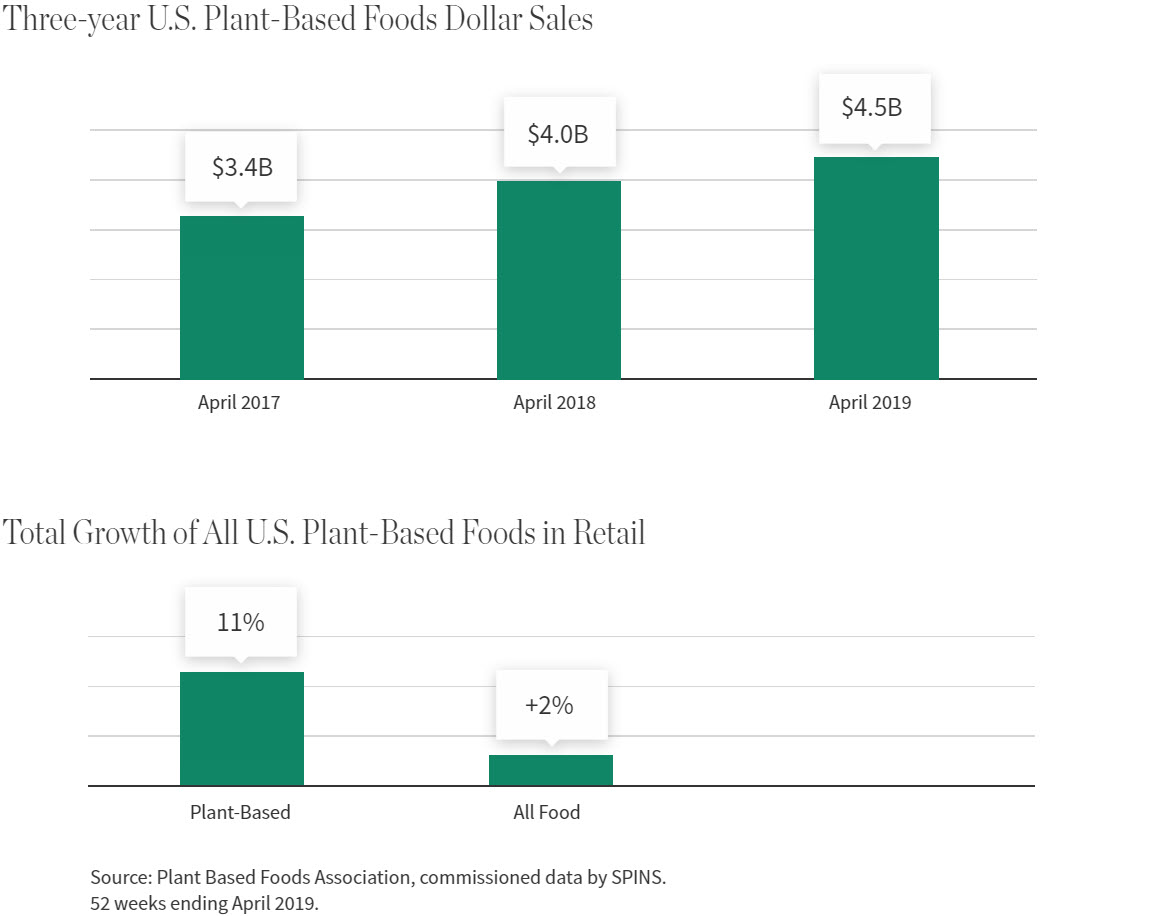That's the question the global food industry is facing.
Finding answers is especially challenging given the projections from the United Nations for world food demand to increase by more than 50% by 2050. Producers will have to do this with finite amounts of land and water even as meat demand grows, driven by wealthier emerging markets. Climate change and a warmer world will continue to put food security at risk.
It's a massive challenge but also a massive opportunity for governments and corporate innovators around the world. A landmark UN report on land management and climate released in August warned of the risks but offered hope if we grow crops more efficiently, waste less food, and convince people to eat less meat.
"Food and agriculture companies are at the heart of what we need most—preserving the environment so we can have a sustainable food supply," says William Blair analyst Larry DeMaria.
The world food chain is a complex system that runs from farm operations to food processors, shippers, and marketers. The players range from small growers to multinational conglomerates, mom-and-pop businesses to online giants. It all adds up to an enormous $5 trillion enterprise that impacts every person in every country, is core to world trade in both raw commodities and manufactured goods, and affects some 3,700,000,000 acres of the world's land for crop production.
From farmers big and small, from big food processors like ADM and Kraft to mega retailers like Walmart and Amazon, sustainable production has become the common theme. The major players are depending on technology more than ever to be their partner.
"We'll need technology to keep track of all steps of the supply chain," says Christophe Beck, president of water technology provider Ecolab, in a recent company blog. "That can be as cutting edge as monitoring the supply chain with a blockchain and the internet of things, where we've barely scratched the surface, or as common-sense as providing food manufacturing facilities and restaurants with apps that automate food safety check lists."

Meat without animals
One of the hottest innovations on the path to be more sustainable has been advances in grain- and vegetable-based "meat" and "dairy" substitutes, known as plant-based foods.
Companies like Beyond Meat and Impossible Foods, for example, have created tasty burgers made from pea, soy, wheat, and potato proteins while Ripple Foods uses a pea protein to produce a dairy milk alternative. These products not only taste and look like meat and milk from animals, but use less land, water, and energy to produce while generating fewer greenhouse gases.
"If you look at livestock rearing globally, it is responsible for about a quarter of greenhouse gas emissions and uses huge resources in terms of land and water," says William Blair equity analyst Jon Andersen. "When you go to a plant protein and remove the animal from the protein supply chain, it's a game changer in terms of the environment."
The ingredients of a Beyond Burger, for example, require 99% less water and 93% less land, generate 90% fewer greenhouse gas emissions and require 46% less energy than what's demanded to produce a traditional beef burger, Andersen said in his May equity research report.
When you go to a plant protein and remove the animal from the protein supply chain, it’s a game changer in terms of the environment.
JON ANDERSEN, William Blair Equity Analyst
On-the-ground efficiency
Technology also continues to change the face of farming at the ground level. Farm equipment manufacturers are developing high-tech tractors, planters, and harvesters that apply GPS as well as planting, growth, and harvest data from individual fields to customize applications that help farmers grow more crops on less land.
"We used to think of ag equipment as bigger, better, faster," says DeMaria. "Now it's really about how to drive efficiencies, not just horsepower but how to use your assets better, to be better with the land and input costs."
For example, Deere has a new planter that operates twice as fast as the last model but has a mapping app that tells a farmer how many seeds and how much fertilizer to apply in the dry areas of his field compared with more fertile sections. Sustainability and efficiency are boosted as the farmer spends less time in the field, uses fewer inputs, and increases crop yield potential.
Technology at Valmont and Lindsay, big irrigation companies, is leading change too. In recent years, they've helped many crop farmers cut their water use in half by convincing them to switch from traditional "flood" irrigation to a mechanized targeted system often operating on a center-pivot. These large steel water sprinklers are often seen in Midwest corn fields.
"Mechanized irrigation isn't new but it has improved over time," says William Blair analyst Brian Drab, who covers the industrial technology sector.
Irrigation companies are refining software with streams of data so farmers know when to water based on local weather, humidity, soil moisture and seed type.
"The machine knows exactly how to incorporate all of those inputs and at the same time the grower can monitor what's happening from anywhere in the world," Drab said. "You can have fields in Nebraska and be on vacation in Paris and monitor all of that from your iPad."
Seeds of change
Plant genetics also continues to improve crops. Midwest seed company Benson Hill Biosystems, for example, is using a new wave of traditional "non-GMO" breeding tools to develop healthier, more sustainable foods.
Matthew Crisp, co-founder and CEO of Benson Hill, said in a William Blair white paper that the company has several projects underway including: increasing the photosynthetic efficiency trait of the corn plant; partnering with Anheuser-Busch InBev to develop more productive and sustainable barley varieties; and working with candy maker Mars to improve the climate resilience of cacao trees, which are the source of chocolate production.
William Blair analyst DeMaria, who recently returned from Europe after visiting clients there, said he saw a big step up among them to invest in companies with strong sustainability initiatives.
"The name of the game for the ag companies is to reduce waste, increase yields, and farm more efficiently," he said. "There is real capital being diverted for funds to invest this way and that's what is going to drive change."
To receive William Blair research reports, contact your advisor. View disclosure information.
Demand for Plant-based Foods Driven by Innovation and Investment
Consumers young and old seeking more nutritious, less-processed food produced under sustainable conditions are turning to plant-based beverages and meat substitutes. They want what's good for health and good for the planet.
"These forces are significantly impacting the level of innovation that is taking place in food and beverage and the supply chain, not only the finished goods on the shelf but the ingredients that go into them," said John LeVert, who heads William Blair's investment banking branded food and beverage team.
U.S. retail sales of plant-based foods have grown 11% in the past year, bringing the total plant-based market value to $4.5 billion, the Plant Based Foods Association says. Plant-based leader Beyond Meat increased sales 287% in its most recent quarter, according to public filings. Plant-based meat now accounts for 2% of retail packaged meat sales while the penetration of plant-based dairy alternatives is 13%.
"Whether it's plant-based proteins like Beyond Meat or Impossible Food burgers or plant-based beverages like Oatly and Ripple Foods, I think people are realizing that plant-based things can have more nutritional benefits and might mitigate some of the health risks and environmental costs associated with consuming traditional animal proteins," LeVert said.
"Impossible Foods and Beyond Meat have been at the forefront of this and why they are getting the attention of media," said LeVert.
"When we took Beyond Meat public in May, the stock traded up 800% in a couple months. That validates there's public interest in participating in this. Public investors are anticipating that the company capturing even a small portion of meat eating could be a huge market over the next 10-15 years."


